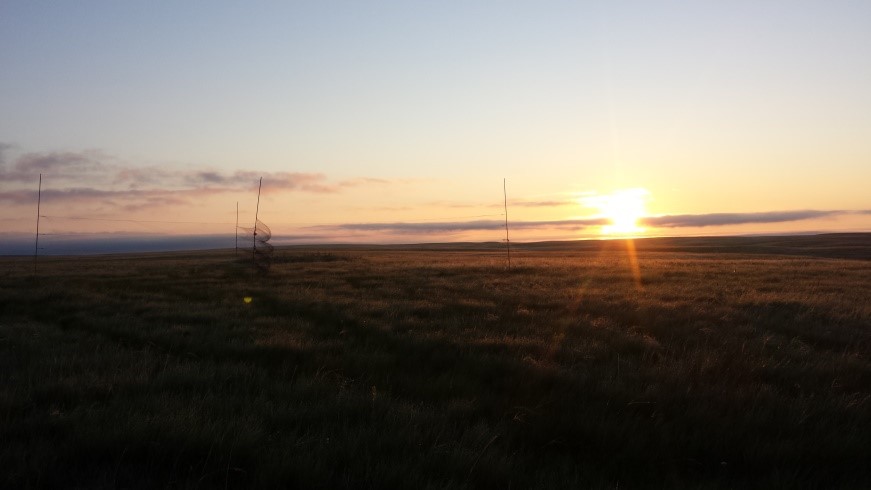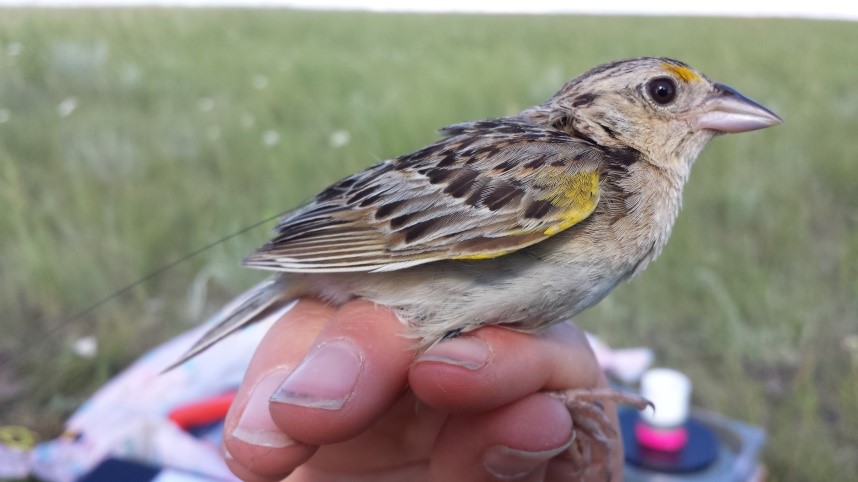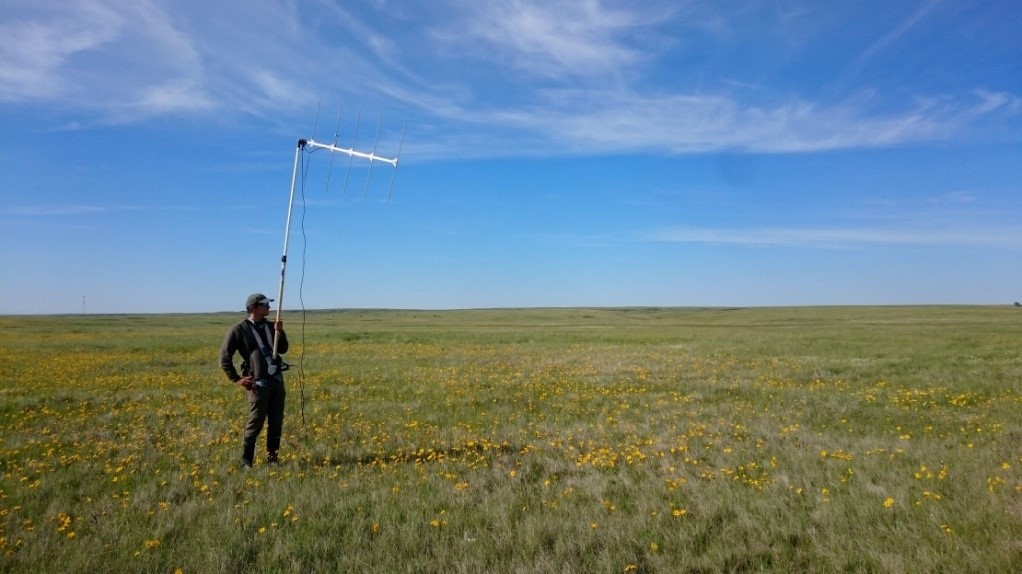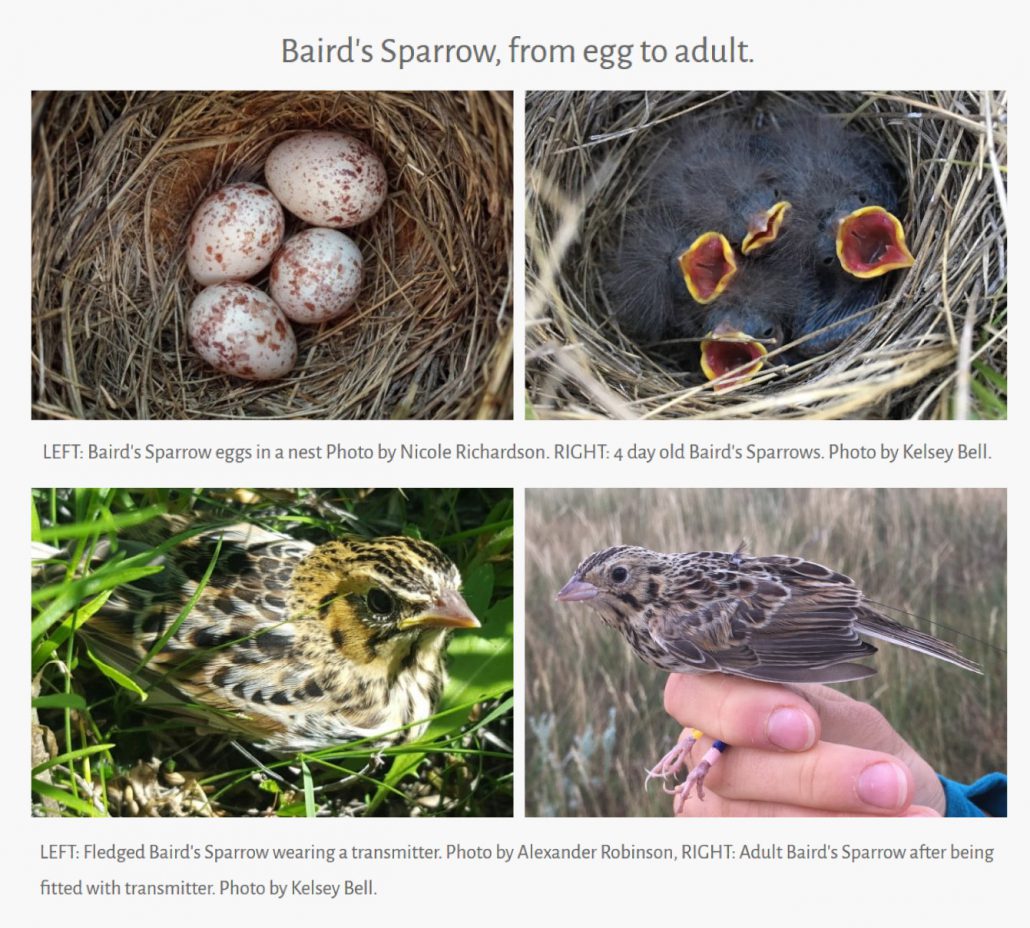By Kaitlyn Wilson, North Dakota Field Crew Leader
Bird Conservancy of the Rockies, working alongside partners including North Dakota Game and Fish Department, just completed a second summer season studying breeding season survival in adults and juveniles of nesting Baird’s and Grasshopper Sparrows in the Northern Great Plains of North Dakota and Montana.

The vast expanse of the prairie – it may look like just grass, but that grass was bustling with the activity of nesting grassland birds! Photo by Kaitlyn Wilson.

The day starts bright and early when you’re chasing sparrows in the grassland. Pictured is a net set-up at sunrise.
Photo by Nicole Richardson.
When we first arrived at the beginning of the season, the species we were looking for had not yet returned from their wintering grounds in Mexico. Then, one morning, the musical trill of a Baird’s Sparrow broke through the wind of the prairie. It was followed by the insect-like trills of a Grasshopper Sparrow. The birds had found their way back once again, and the breeding season had begun!

An adult Grasshopper Sparrow after being fitted with a transmitter. You can see the antenna extending off the back of the bird. Photo by Nicole Richardson.
The males are always eager to defend territory. We lured them into mist nets by playing a Baird’s Sparrow song, imitating a rival. Within a minute our first sparrow darted into the net in an attempt to run off the intruder. Each captured bird was fitted with a transmitter. We used radio telemetry to track their exact location every day, in an effort to determine survival rates and habitat use.

Pictured is one of our Montana crew members using the radio telemetry equipment to track birds. Sometimes, the birds move out of range and we spend considerable time scanning the area looking for “lost birds.” This may involve many hours spent listening to the mind-numbing static coming from our receivers, just waiting for a signal “ping” from one of our birds. During one search, we realized that meadowlarks could produce a call identical to the sound of a telemetry signal, making the task even trickier!
Photo by Sara Burns.
As we continued capturing males, the females began to sporadically arrive. The beginning of the nesting season for Grasshopper Sparrow becomes obvious as they start acting ‘nesty’—making chipping calls much different than their usual calls. Baird’s Sparrows are more elusive, only giving their nest away when flushed, or by flying circles overhead and chipping because we were getting too close to their nest.
 We monitored nests for survival (fail or fledge), and also attached transmitters to nestlings to track their survival. Unfortunately, many of the nests did fail, often due to depredation. Predators include Northern Harriers, coyotes, ground squirrels, weasels, and snakes. Some nests were abandoned for unknown reasons. The failures, though disheartening, give insights into the challenges facing these birds.
We monitored nests for survival (fail or fledge), and also attached transmitters to nestlings to track their survival. Unfortunately, many of the nests did fail, often due to depredation. Predators include Northern Harriers, coyotes, ground squirrels, weasels, and snakes. Some nests were abandoned for unknown reasons. The failures, though disheartening, give insights into the challenges facing these birds.
Grassland songbirds are declining at a steeper rate than any other group of birds in North America. According to the State of North America’s Birds 2016 report, 27% of the 45 grassland species have lost, on average, almost 70% of their continental populations since 1970. A likely cause is habitat loss. We look forward to another season in 2017 with opportunities to learn more and hopefully shed light on what can be done to ensure their song continues to be heard across the wide open landscape.
Help support our efforts to conserve birds across their full life cycle! Please visit our Colorado Gives Day page. You can pre-schedule your contribution NOW to be debited on December 6th, Colorado Gives Day. All contributions received that day are matched with incentive funds from Community First Foundation. Thank you for your support! Together, we are making a difference to bird conservation efforts across the Americas!



